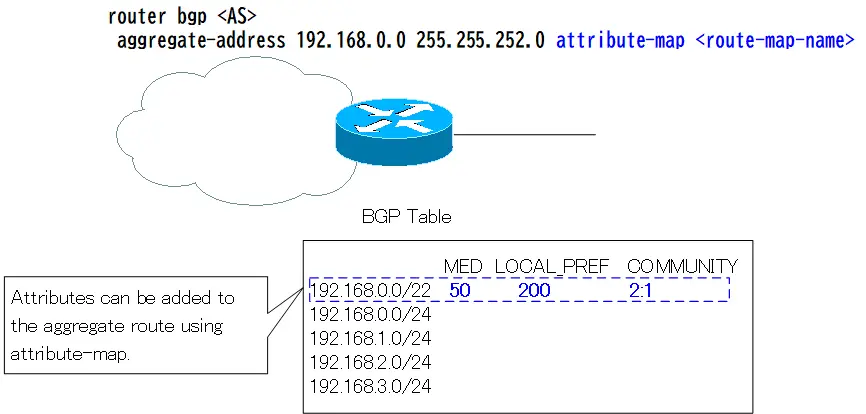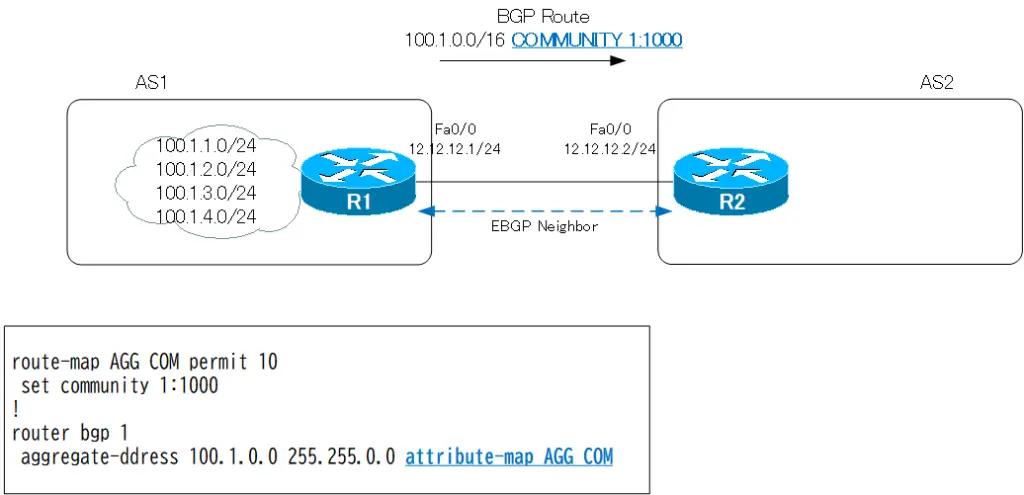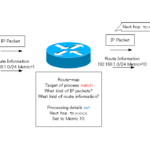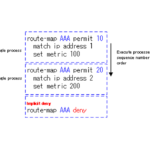Table of Contents
Overview
The aggregate-address command for aggregating BGP routes on Cisco routers has many options. The options are divided into two categories.
- What to do with the attributes of the aggregate route
- How to handle pre-aggregation routes
The attribute-map is an option for “what to do with the attributes of the aggregate route”. The attribute-map allows attributes to be added to the aggregate route.
aggregate-address command : attribute-map option
Aggregate route generated by the aggregate-address command naturally has path attributes added to it as well. By default, the following path attributes are added.
- ORIGIN:IGP
- NEXT_HOP:0.0.0.0
- AS_PATH: empty
- WEIGHT:32768
- LOCAL_PREFERENCE:100
- MED: none
- AGGREGATOR: Local AS number and Router ID
- ATOMIC-AGGREGATE
Attributes such as MED, LOCAL_PREFERENCE, and COMMUNITY can be added when generating aggregate routes using the attribute-map option.

The attribute-map option specifies the route map name. The route-map set command sets the attribute to be added to the aggregate route.
aggregate-address attribute-map
(config)#router bgp <AS>
(config-router)#aggregate-address <network-address> <subnetmask> attribute-map <route-map-name>
<AS>: AS number
<network-address>: Network address of the aggregate route
<subnetmask>: Subnet mask of the aggregate route
<route-map-name>: route-map name
The route map specified by attribute-map does not need to match condition. This is because the target is determined to be an aggregate route.
Related articles
The following article explains the route-map in more detail.
aggregate-address attribute-map configuration example
Network diagram and Initial configuration
Configure the attribute-map option for aggregate-address on R1 in the following network diagram.

The BGP-related configuration for R1 and R2 prior to configuring aggregate-address is as follows
R1 Initial Configuration
interface Loopback0 ip address 100.1.2.1 255.255.255.0 secondary ip address 100.1.3.1 255.255.255.0 secondary ip address 100.1.4.1 255.255.255.0 secondary ip address 100.1.1.1 255.255.255.0 ! router bgp 1 network 100.1.1.0 mask 255.255.255.0 network 100.1.2.0 mask 255.255.255.0 network 100.1.3.0 mask 255.255.255.0 network 100.1.4.0 mask 255.255.255.0 neighbor 12.12.12.2 remote-as 2 neighbor 12.12.12.2 send-community ip bgp-community new-format
R1 has established an EBGP neighbor with R2 and advertises routes 100.1.1.0/24 through 100.1.4.0/24 with the network command.
R2 Initial Configuration
router bgp 2 neighbor 12.12.12.1 remote-as 1 neighbor 12.12.12.1 send-community ip bgp-community new-format
R2 simply configures an EBGP neighbor with R1.
Since COMMUNITY attributes are handled, the following commands are also configured on R1 and R2.
- neighbor send-community
- ip bgp-community new-format
The neighbor send-community command does not remove the COMMUNITY attribute that is added to the BGP route.The ip bgp-community new-format command is configured to make the COMMUNITY notation clearer.
Advertise aggregate route on R1
Generate route information 100.1.0.0/16, which aggregates 100.1.1.0/24 to 100.1.4.0/24 on R1.
R1 Generate aggregate route
router bgp 1 aggregate-address 100.1.0.0 255.255.0.0
With this configuration, the aggregate route 100.1.0.0/16 is generated, placed in the BGP table, and advertised to R2. Verify the attribute of the aggregate route 100.1.0.0/16 at this time. To do so, view the results of show ip bgp 100.1.0.0 on R1.
R1 Verifying Aggregate Route Attributes
R1#sh ip bgp 100.1.0.0 BGP routing table entry for 100.1.0.0/16, version 6 Paths: (1 available, best #1, table Default-IP-Routing-Table) Advertised to non peer-group peers: 12.12.12.2 Local, (aggregated by 1 100.1.1.1) 0.0.0.0 from 0.0.0.0 (100.1.1.1) Origin IGP, localpref 100, weight 32768, valid, aggregated, local, atomic-aggregate, best
Aggregate route attributes are marked with atomic-aggregate and aggregator, but other attributes such as Origin and Local_preference are the same as the route generated by the network command.
Adding attributes to aggregate routes can also be done by applying a route-map outbound when advertising. However, with attribute-map, attributes can be added when aggregate route is generated.
Attribute addition to aggregate route using attribute-map
Let’s use attibute-map to add COMMUNITY to the aggregate route. After the attribute-map, specify a route map. This route map should be considered very simple. The match condition is not required for the route map after attribute-map, since the aggregate route generated by the aggregate-address command is the target, so there is no need to specify match condition. Just use the set command alone to set the attributes you want to add to the aggregate route.
Now, as an example, let’s consider configuring an attribute-map to add COMMUNITY 1:1000 to an aggregate route. First, create a route-map (AGG_COM) to add COMMUNITY as follows
R1 Configure route-map for attribute-map
route-map AGG_COM permit 10 set community 1:1000
This route map is then applied with the attribute-map option of aggregate-address command.
R1 attribute-map option
router bgp 1 aggregate-ddress 100.1.0.0 255.255.0.0 attribute-map AGG_COM
This will add COMMUNITY 1:1000 to the aggregate route 100.1.0.0/16. Let’s verify this by viewing the BGP table on R1.
R1 Aggregate route 100.1.0.0/16
R1#sh ip bgp 100.1.0.0 BGP routing table entry for 100.1.0.0/16, version 7 Paths: (1 available, best #1, table Default-IP-Routing-Table) Advertised to non peer-group peers: 12.12.12.2 Local, (aggregated by 1 100.1.1.1) 0.0.0.0 from 0.0.0.0 (100.1.1.1) Origin IGP, localpref 100, weight 32768, valid, aggregated, local, atomic-aggregate, best Community: 1:1000
If detailed information on the aggregate route 100.1.0.0/16 in the BGP table is verified, you can see that COMMUNITY 1:1000 is appended in the last line.

Let’s also look on R2, which receives this route.
R2 BGP Table
R2#sh ip bgp 100.1.0.0 BGP routing table entry for 100.1.0.0/16, version 7 Paths: (1 available, best #1, table Default-IP-Routing-Table) Flag: 0x880 Not advertised to any peer 1, (aggregated by 1 100.1.1.1) 12.12.12.1 from 12.12.12.1 (100.1.1.1) Origin IGP, metric 0, localpref 100, valid, external, atomic-aggregate, best Community: 1:1000
On R2, you can also see that the aggregate route 100.1.0.0/16 with COMMUNITY 1:1000 is also being received.
Summary
Points
- attribute-map is an option for “what to do with the attributes of the aggregate route”. It is used to add attributes to the aggregate route.
- Specify a route map after attribute-map. The route map is set to the attribute to be added without the match condition.
How the BGP works
- BGP Basic Configuration and Verification Commands
- BGP Neighbor Status
- BGP Neighbor Authentication
- BGP Well Known Mandatory Attributes
- Illustration: BGP Best Path Selection
- BGP KEEPALIVE timer/Hold time Configuration
- BGP Route Minimum Advertisement Interval Configuration
- BGP Route Dampening
- BGP Route Filter Overview
- BGP Route Filter : distribute-list
- BGP Route Filter : distribute-list Configuration Example
- BGP Route Filter : prefix-list
- BGP Route Filter : prefix-list Configuration Example
- BGP Route Filter : filter-list(AS_PATH ACL)-
- BGP Route Filter : filter-list(AS_PATH ACL) Configuration Example
- BGP Route Filter : Route-map
- BGP Route Filter : route-map Configuration Example
- BGP neighbor allowas-in command
- BGP neighbor as-override command
- BGP Route RIB Failure
- BGP Route Administrative Distance Adjustment
- BGP Route Load Balancing
- BGP Auto Summary
- BGP Route Summary : network command
- BGP Route Summarization : network command configuration example
- BGP Route Summary aggregate-address command
- aggregte-address command : summary-only opiton
- aggregte-address command : attribute-map opiton
- aggregte-address command : as-set opiton
- aggregte-address command : advertise-map opiton
- BGP Selective Aggregation Overview
- BGP Selective Aggregation : suppress-map
- BGP Selective Aggregation : unsuppress-map
- BGP local-as
- BGP neighbor remove-private-AS
- bgp fast-external-fallover
- BGP Prefix Limitation

